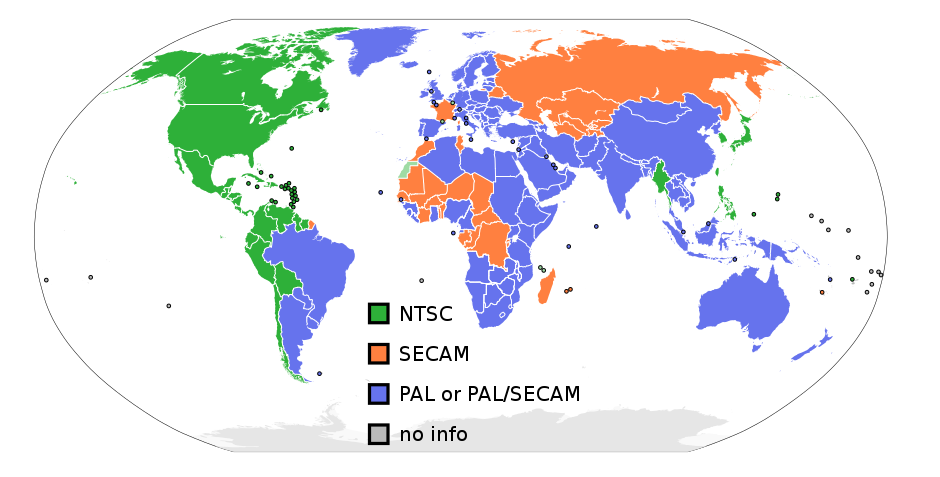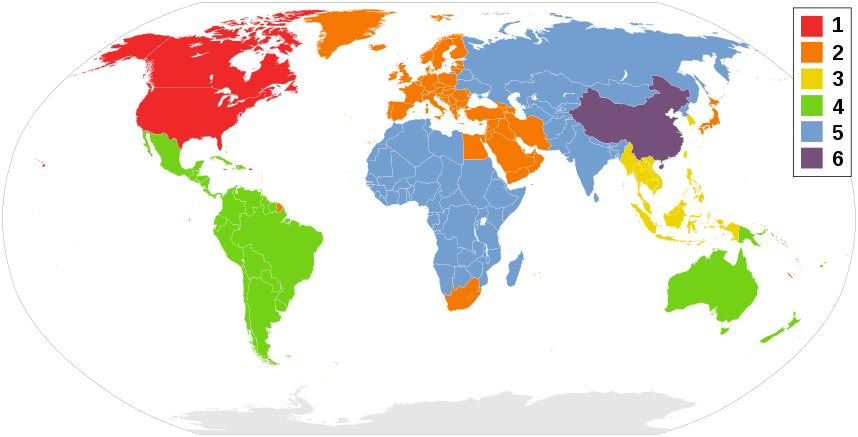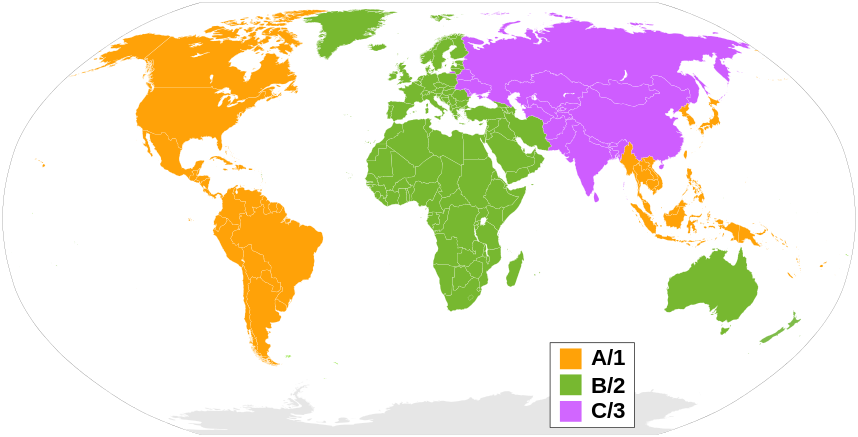DVD and blu-ray distributors utilize two primary methods of applying digital rights management (DRM) when it comes to international distribution:
- Video formats, which vary in display resolution, aspect ratio, refresh rate, color capabilities and other qualities. Different countries use different broadcast standards that apply different video formats, which include both analog and digital formats. Analog video formats were carried over to DVD’s.
- Region codes, which is a DRM technique designed to allow rights holders to control the international distribution of a DVD & blu-ray releases, including their content, release dates, and prices, all according to the appropriate region.
Analog Video Formats Applied to DVD’s
The main types of video formats that are used in different countries based upon their broadcasting standards are as follows:
- NTSC was named after the National Television System Committee and is the analog television color system that was used in North America from 1954 until digital conversion. It was also used in most of the Americas (except Brazil, Argentina, Paraguay, Uruguay, and French Guiana), Myanmar, South Korea, Taiwan, Philippines, Japan, and some Pacific island nations and territories.
- SECAM, which stands for Séquentiel couleur à mémoire, (or “Sequential colour with memory”), is an analogue color television system first used in France beginning in 1956. It was then adopted by the former Soviet Union and used in client states and colonies.
- PAL, which stands for Phase Alternating Line, is a color encoding system for analog television that is used by broadcast television systems in most countries that broadcast at 625-line / 50 field (25 frame) per second (576i), but variants occur due to how the audio carrier frequency is handled:
- Standards B/G are used in most of Western Europe, Australia, and New Zealand
- Standard I in the UK, Ireland, Hong Kong, South Africa, and Macau
- Standards D/K (along with SECAM) in most of Central and Eastern Europe
- Standard D in mainland China. Most analogue CCTV cameras are Standard D.
- Other PAL Variants
- PAL-M in Brazil.
- PAL-N in Argentina, Paraguay and Uruguay.

Vido Format Usage Map
Region Codes
Region codes work because the vast majority of DVD and blu-ray players sold around the world are region-locked, which means that they won’t play discs that are meant for regions outside of the intended region. Regions devised for DVD’s are not the same as regions devised for blu-rays.
DVD Region Codes
There are a total of 10 region codes for DVD’s. DVDs may use one code, a combination of codes (multi-region), every code (all region) or no codes (region free).
DVD Region codes 1 through 8 are defined as follows:
- Canada, United States, Puerto Rico.
- Europe (as of 2020 will include Belarus, Ukraine, Moldova, and the 3 Caucasus countries), Egypt, West Asia, Japan, South Africa, Greenland, and French Guiana.
- Southeast Asia, South Korea, Taiwan, Hong Kong and Macau.
- Latin America (the Americas except Canada, French Guiana, Puerto Rico and the United States) and Oceania.
- Africa (except Egypt and South Africa), Russia, Central Asia, South Asia, Mongolia, and North Korea.
- Mainland China.
- Reserved for future use, MPAA-related DVDs and “media copies” of pre-releases in Asia.
- International venues such as aircraft, cruise ships and spacecraft.
DVD Region 0 include regions 1 through 6, but do not necessarily take the video format into account. DVD Region ALL means all 1-8 flags are set, allowing the disc to be played in any location, on any player.

DVD Region Codes Map
Blu-ray Region Codes
Blu-ray discs use a region-code system that is much simpler than the for DVD’s as it only has three regions, labeled A, B and C. As with DVDs many Blu-rays are encoded region 0 (region free), making them suitable for players worldwide.
- Region A: The Americas and their dependencies, East Asia (except mainland China and Mongolia), and Southeast Asia; excludes instances that fall under Region C.
- Region B: Africa, Middle East, Europe (except Russia), Australia, New Zealand, and their dependencies; excludes instances that fall under Region C.
- Region C: Central Asia, mainland China, Mongolia, South Asia, Russia.

Blu-ray Region Codes Map
References





You must be logged in to post a comment.